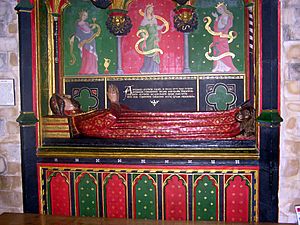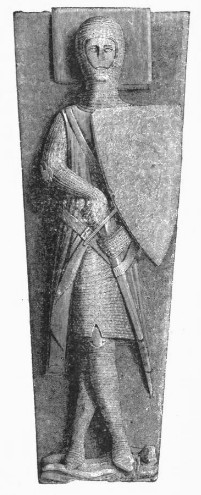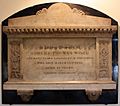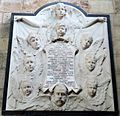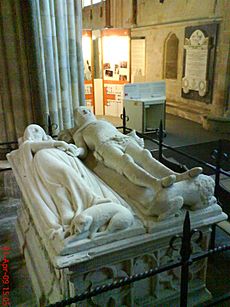English church monuments facts for kids
A church monument is a special kind of memorial found inside a Christian church. It's built to remember someone who has passed away. These monuments can be simple plaques on a wall, or they can be large, fancy structures.
Sometimes, a monument includes a sculpted figure of the person it remembers. This figure is called an effigy. These monuments are usually placed near where the person is actually buried. But sometimes, a monument is a cenotaph, which means it honors someone buried somewhere else.
Today, church monuments are seen as beautiful works of funerary art. They are also very helpful for historians. They show us what clothes and armour people wore long ago. For people studying family history, they provide important dates and family connections. They also help us understand heraldry, which is the study of family symbols and coats of arms. From the mid-1400s, many monuments even started to show real portraits of people, not just general ideas of them.
Amazing English Church Monuments
England has a huge number of church monuments. Many of them are very old and still in great condition. They are also considered some of the best in the world for their artistic beauty. You can find wonderful examples in big cathedrals and smaller local churches all across the country.
-
This tomb shows a knight with crossed legs. It's thought to be Hamon Belers, from around 1300, in St Mary's Church, Melton Mowbray, Leicestershire.
-
This is the cadaver tomb of Bishop Richard Fleming in Lincoln Cathedral. The top part shows him as if he were alive. The bottom part shows his body as a decaying corpse in a shroud (1431).
-
These are alabaster figures of John Harington, 4th Baron Harington and his wife Elizabeth Courtenay. They are at the Church of St Dubricius, Porlock in Somerset, from around 1471.
-
This monument honors John Manners, 4th Earl of Rutland. It's in St Mary the Virgin's Church, Bottesford, Leicestershire, made by Gerard Johnson the elder in 1588.
-
This monument is for John Wrey (died 1597). It was moved to St Peter's Church, Tavistock, Devon, in 1924.
-
This monument is for Sir Edward Denny and his wife at Waltham Abbey Church (1600). The small kneeling figures below are his ten children, often called "weepers."
-
The Layer Monument is a colorful marble wall monument. It's in the Church of Saint John the Baptist, Maddermarket, Norwich, from around 1600.
-
This monument is for Richard Stone and his wife. It's at St Mary's, Holme-next-the-Sea in Norfolk (1607).
-
This is Thelwall's wall monument. It's in the chapel at Jesus College, Oxford (1630).
-
This monument with a sculpted figure is in Worcester Cathedral, from around 1640.
-
The monument to Sir John Hotham is in St Mary's, South Dalton, East Yorkshire. The sculptures were made after 1697.
-
This monument honors Major-General Sir William Ponsonby. It's in the crypt of St Paul's Cathedral, London (1815).
-
A Victorian wall monument from 1890. It's at St Paul's Church, Shadwell, London.
-
This monument is for Emily, the wife of Admiral Charles Lister Oxley. It's in Ripon Cathedral. The angelic heads show the couple and their seven children (1898).
-
This bronze monument is for Bishop Edward King. It's at Lincoln Cathedral and was made by William Blake Richmond (1913).
-
This is a wall memorial to Bishop John Macmillan. It's in Guildford Cathedral, Surrey (1956).
A Famous Poem About a Tomb
One of the most well-known poems by the English poet Philip Larkin (who lived in the 1900s) was inspired by a church monument. The poem is called "An Arundel Tomb." It's about a 14th-century monument in Chichester Cathedral. Look closely at the monument in the picture. You can see a lion at the feet of the lord and a dog at the feet of the lady.
Images for kids
-
The subject of An Arundel Tomb in Chichester Cathedral


